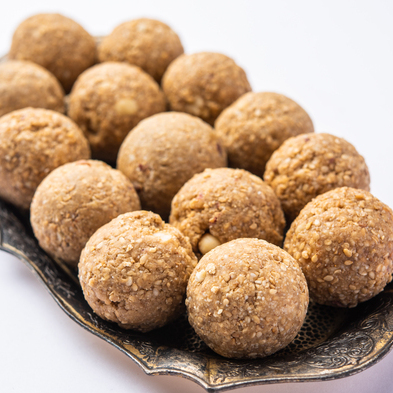Once every year, we celebrate an Indian festival that follows the solar calendar and not the lunar one, which is why it falls on the same day every year.
[the_ad id=”6076″]
Yes! It is Makar Sankranti that falls on January 14th (or rarely on 15th). This is one pan-India festival. It is the celebration of Sun’s movement towards north and with that begins the end of harsh winter. The festivities are called Makar Sankranti in Maharashtra, Pongal in Tamil Nadu/Andhra Pradesh, Lohri/Maghi in Punjab, Bihu in Assam, and Uttarayan in Gujarat. Other than the coinciding dates, some common threads are the Sun, the harvest, the food and festivities and the Wisdom of Ayurveda.
Food is at the centre as these are harvest celebrations. Sesame, rice, millets, jaggery/gur, fresh berries (Indian Ber), seasonal greens are some of the mainstays. Tilguls (white sesame laddus) and chikki in Maharashtra and Gujarat, black sesame laddus with unrefined brown jaggery in Uttar Pradesh, crispy sesame Gajak in North India, pithey (rice flour pancakes) in Bengal and Assam, varieties of Pongal (Venn Pongal, Sakkarai Pongal, Puli Pongal) and the list goes on.
Here’s a look at the festivities one by one:
Lohri- Janaury 13
Mainly celebrated in Punjab, Lohri is also celebrated in Haryana, Delhi, Uttar Pradesh and Uttarakhand as the beginning of Rabi crop harvest season. There’s bonfire, folk songs, and traditional dance. Seasonal foods: mustard greens, corn flatbread (the famous makke di roti and sarson da saag), sweets of ghee, til (sesame), peanuts, edible gum, dry fruits, puffed rice, dry coconut, new-harvest wheat flour and jaggery take center stage.
Wisdom of Ayurveda: All of these are hot potency foods with amazing health benefits, which help people sail through the harsh North Indian winters. Songs and cultural activities contribute to mental wellbeing.
Makar Sankranti and Uttaran: January 14
Makar Sankranti is associated with northward movement of the Sun. This is called Uttarayana or Uttaran (in Gujarat). A good yield is a symbol of prosperity, which makes a tribute to the Sun due again.
In Maharashtra, the festivities start on January 13th that marks Bhogi and bajra millet flatbread is eaten with a special mixed vegetable that has all the season’s goodies slow-cooked in a sesame-based gravy.
Makar Sankranti is celebrated with consumption and distribution of sesame-jaggery laddus (Tilgul) in the community. There’s also stuffed flatbread with peanut and jaggery stuffing (Gulachi poli). A get-together of ladies begins (this goes on for around 15-21 days). Sharing Tilgul is also associated with sweetness of speech and is a reminder to forget all differences and live as a happy, healthy community.
In Gujarat, the festive preparations are bajra no khichdo (a preparation of millet khichdi), undhiyu (a mix of seasonal vegetables such peas, several legumes, unripe bananas, eggplant, grounded coconut, potatoes and purple yam), til laddus and Surati gulab jamun. Interestingly, the undhiyu is one dish that is cooked together as a community (looking at the number of ingredients, you would not be surprised!), where each household can bring in the ingredients they have, and people slow-cook the recipe in earthen pots by the bonfire over light talk and fun.
Wisdom of Ayurveda: The hot potency, high energy, but moderately fatty food counters the moderate winters of the region. The community activities are meant to foster mental and social wellbeing. A reminder to forget all differences and share season’s goodies further bonds a healthy society.
Pongal- January 13 to January 15
Celebrated in the southern states of Tamil Nadu, Telangana, Andhra Pradesh, this is a celebration of rice. The festivities begin with Boghi on January 13th, which is dedicated to Indra Dev, the God of rains. In South India, winters are not so harsh, but rains can be tricky. The harvest and entire wellbeing depends on good rain (no less, no more)!
People worship the Sun God on Thai Pongal-January 14th and Sun worship is one of the most important Pongal festivities. Pongal symbolises prosperity and abundance (the word pongal literally means boiling over out of abundance)! The dishes Venn Pongal (savoury one with cashews), Sakkarai Pongal (sweet one with coconut) and Puli Pongal (tangy with tamarind pulp) are all made from new-harvest rice and have the symbolic boiling over involved in their cooking. Besides Pongal varieties, the payasam is another dessert made with milk, jaggery and rice/moong dal/semolina. Food is first offered to God and then shared among other community members. Domestic cattle are family and they partake of the goodies too. The third day of Pongal festivities, January 15th is entirely dedicated to cattle (Mattu Pongal).
Wisdom of Ayurveda: The ingredients used here are used around the new-harvest rice at the center. While harvest celebration is incomplete without sweets, desserts prepared are not fat-laden and are consumed in moderation. The new-harvest rice is more difficult to digest compared to aged rice, hence the other ingredients used are all digestives; mustard seeds, tamarind, curry leaves, cumin, black pepper, lemon juice, green/red chillies, and asafetida. While we know that moong dal, tur dal, chana dal, urad dal are added for the protein punch; as per Ayurveda, these pulses balance the Kapha aggravating property of new-harvest rice and create a balance. This is how one staple grain (rice) can give wholesome, balanced, and tasty food.
Magh Bihu- January 14th
This is East India’s version of the harvest festival. This is a 2-day celebration and is dedicated to the Fire God. Feast is an important part of the celebration and people from different tribes and communities gather to celebrate together. There’s bonfire and community games- pot breaking, buffalo fights, egg fights, and more. Pithas are at the center of feasts. These come in many varieties- some are similar to a sweet rice pancakes and some are like dumplings. Varieties include: til (sesame) pithas, narikol (coconut) pithas, ghila (jaggery and sticky rice) pithas, tekeli (jaggery sugar and coconut are prepared by steaming in a kettle) pithas and so on. Bihu special vegetable preparation is Laai Xaak Khaar, made of mustard greens, khar (baking soda) and spices. Other Xaak (greens) include colocasia leaves and fiddlehead ferns. Coconut sweets, laddus, payokh (rice pudding), and deep-fried sweet and savoury snacks are other Bihu specialties. Masor tenga (tangy fish curry) and mangsho (mutton curry) are popular non-vegetarian items.
Harvest celebrations in Odisha and West Bengal are similar. People in Odisha eat akara chaula (made of rice with jaggery, milk, banana, fresh cottage cheese and sugarcane). In West Bengal, there is an abundance of patishapta (coconut and sugar stuffed pancakes), gokul pithe (deep-fried patties of khoya, date palm jaggery and coconut), and nolen gurer payesh (a thickened rice and milk pudding with date palm jaggery).
Wisdom of Ayurveda: What is true of South India is also partly true of North-east India and East India. The winters are not very harsh, but rainfall is high. Rice takes center stage here too; however, the local goodies like date palm jaggery, the local greens, fresh water fish adds the twist. The local cuisine is unique, which is striking different from the one of South India. Potatoes, especially new-harvest potatoes are equally important. Potato dishes are mostly deep-fried or oil-laden to counteract the Vata aggravating property of potatoes. Adding spices and herbs like coriander and mint helps digestion!
Bottom line: Eat your local, traditional food around this festive season as it is full of goodness and ancient wisdom.
Here’s wishing Happy Healthy Lohri, Makar Sankranti, Uttaran, Pongal, and Bihu to all!
Source:

Dr. Mamta Lele- Pawara
(MD Ayurveda-Internal Medicine, CRAV-Kayachikitsa, MA Sanskrit)
